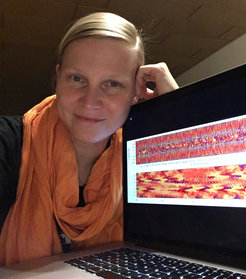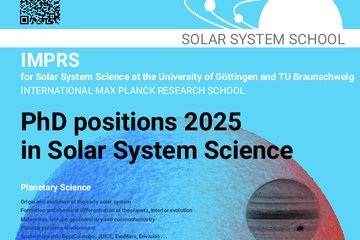Sunlike Stars: From Chaos to Magnetism
MPS-scientist Maarit Käpylä receives a Consolidator Grant from the European Research Commission.
Stellar magnetic fields behold a great mystery. They originate from chaotic plasma flows in the outer envelope of the star via a hydromagnetic dynamo mechanism. Therefore, it is no surprise that stars display a great variety of magnetic phenomena that are stable neither in time nor space. Over longer time scales, however, stellar magnetic fields exhibit remarkably coherent features as big as the star itself that undergo rather regular time variation. One example is the Sun’s 11-year magnetic cycle, during which our star is sometimes more, sometimes less magnetically active. Finding out, how this order can co-exist with the chaos and how the stellar dynamos work in detail, is the goal of Dr. Maarit Käpylä, researcher at the Max-Planck-Institute for Solar System Research (MPS) and the Aalto University in Finland. The European Research Commission (ERC) supports her endeavor of developing theoretical and numerical models that describe the crucial processes both within the Sun and other stars with a Consolidator Grant.

No star is as familiar to us as the Sun. For centuries, researchers have peered at our star through telescopes; since the beginning of the space age, space probes provide even more precise observational data. Nevertheless, the Sun’s complex magnetic nature is far from being completely understood. Scientists are searching for a theoretical description that explains how the combination of solar rotation and hot plasma currents bubbling to the surface produce the large variety of solar magnetic phenomena we know. These include sunspots, dark areas of high magnetic field strength on the Sun’s visible surface, which in the course of an eleven-year solar cycle occur increasingly nearer to the equator.
Although there are theories that reflect the solar behavior quite well, this alone is not enough. "We like to think that our Sun is a very special star. But that's not true”, Dr. Maarit Käpylä explains. Today, many stars are known that closely resemble the Sun in terms of magnetic activity and rotational properties. In addition, the stellar family tree includes many others: for example, younger stars that rotate faster than the Sun, are significantly more active and whose gigantic star spots in phases of high activity occur preferably near the poles; or stars, in which - unlike the Sun - the rising, seething plasma flows fill the entire interior. When the Sun is viewed as just another star amongst many, it can be noticed that the collective behavior of their dynamos – also that of the Sun - is not well understood in the framework of any prevailing theory.
"Only a theory that proves itself with regard to all these stars captures the truly fundamental mechanisms," says Käpylä. In the framework of the now approved Consolidator Grant, Käpylä and her team plan to develop such a unified theoretical description with the help of computer simulations over the next five years. In these models, chaotic and turbulent processes in the stars’ interior play a crucial role. In the past, these were often not fully accounted for.
With the so-called Consolidator Grants, the European Research Commission (ERC) supports young scientists who have already set up an independent, excellent research group and now want to strengthen their research work. The funding of up to two million euros can be granted for up to five years.

Dr. Maarit Käpylä studied at the University of Oulu in Finland and holds a PhD in astronomy. After research stays in Newcastle (England), Toulouse (France), and Copenhagen (Denmark), she settled in Helsinki University, Finland, in 2005 as an Academy of Finland Research Fellow, and in 2013 moved to Aalto University Computer Science Department. Her DYNAMO team was one of the five research groups in a consortium “ReSoLVE” to receive the prestigious award of the Finnish Centre of Excellence in 2014, the first ever established in space sciences and astronomy. Since 2016 she has been leading the research group "Solar and Stellar Magnetic Activity" at the MPS.













